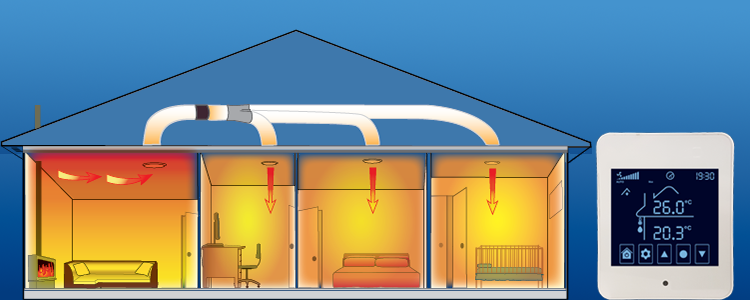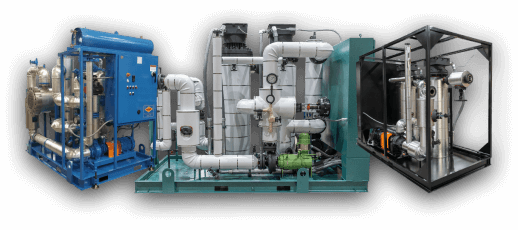Exploring Advanced CFD Modeling in DVS Heat Transfer Systems
Checking out the Perks and Applications of Heat Transfer Solutions in Modern Market
Heat transfer systems play an essential role in modern market. They incorporate different devices such as convection, transmission, and radiation, each adding to reliable thermal monitoring. Industries like manufacturing and aerospace benefit greatly from these systems. As advancements proceed, the assimilation of innovative products and technologies assures to improve energy performance. This development raises vital concerns about the future effects for sustainability and operational prices throughout multiple industries. What exists ahead in this recurring change?
Recognizing Heat Transfer Concepts
Heat transfer concepts are essential to the procedure of different commercial systems. These concepts incorporate the mechanisms of radiation, convection, and conduction, each playing a crucial duty in handling thermal power. Understanding transmission involves assessing exactly how Heat relocates with solid products, while convection concern Heat transfer in fluids, driven by liquid motion. Radiation, distinctive from the other two, entails power transfer with electro-magnetic waves. The efficiency of Heat transfer influences system efficiency, energy usage, and total performance. Efficient thermal administration is necessary in procedures such as air conditioning, home heating, and Heat recovery. By understanding these concepts, sectors can optimize their operations, reduce energy costs, and enhance equipment longevity, thereby adding to an extra effective and lasting commercial landscape.
Secret Kinds of Heat Transfer Equipments
While various industries utilize Heat transfer systems for diverse applications, several key types attract attention as a result of their specific features and efficiencies. The most common kinds include convection, radiation, and conduction systems. Transmission systems transfer Heat with straight call in between materials, making them effective in solid-state applications. Convection systems, on the other hand, make use of liquid activity to transfer Heat, appropriate for home heating or cooling gases and fluids. Radiation systems run without a medium, counting on electro-magnetic waves to move Heat, perfect for high-temperature atmospheres. Each type offers unique purposes, permitting industries to customize their Heat transfer options based on operational requirements, energy efficiency, and cost-effectiveness. Recognizing these systems is vital for enhancing performance in numerous commercial settings.
Industrial Applications of Heat Transfer Technologies
The application of Heat transfer modern technologies in market plays a vital duty in improving power efficiency and maximizing processes. DVS Heat Transfer Systems. By implementing sophisticated Heat exchange systems, business can significantly reduce their ecological impact while enhancing overall efficiency. This combination not only promotes sustainability but likewise aligns with contemporary regulatory and customer needs for greener practices
Power Efficiency Improvements
As markets progressively prioritize sustainability, energy performance improvements in Heat transfer innovations have ended up being essential for decreasing functional costs and ecological influence. Enhanced Heat exchangers, for circumstances, utilize sophisticated products and styles to make the most of thermal efficiency while minimizing energy intake. Incorporating variable rate drives in pumping systems allows for much better control of fluid circulation, leading to substantial power financial savings. The implementation of smart sensors and automation gives real-time surveillance, enabling adjustments that optimize energy use. Furthermore, waste Heat recuperation systems capture excess thermal energy, converting it into usable power. These advancements not only improve energy efficiency yet also add to a more sustainable commercial landscape by reducing greenhouse gas discharges and supporting conformity with environmental laws.
Refine Optimization Techniques
Process optimization methods are essential in boosting the performance and performance of Heat transfer technologies in industrial applications. These techniques include refining processes to take full advantage of Heat transfer efficiency while decreasing power intake and operational costs. Methods such as computational liquid characteristics (CFD) modeling allow engineers to assess and imitate Heat transfer scenarios, identifying locations for renovation. Furthermore, real-time tracking systems can provide beneficial data on temperature level gradients and flow rates, making it possible for changes that enhance efficiency. In addition, carrying out sophisticated control techniques, such as predictive analytics, can improve system responsiveness to varying functional demands. By applying these optimization strategies, markets can achieve higher thermal efficiency, minimized downtime, and enhanced item high quality, inevitably resulting in increased competitiveness in the industry.

Environmental Influence Reduction
While commercial Heat transfer modern technologies are vital for functional efficiency, their application likewise provides possibilities for substantial environmental influence reduction. By enhancing power efficiency, these systems reduce gas consumption, causing reduced greenhouse gas exhausts. For instance, progressed Heat exchangers can recuperate waste Heat, rerouting it to preheat incoming fluids, therefore decreasing power demands. On top of that, the combination of Heat transfer technologies in eco-friendly energy systems, such as solar thermal and geothermal applications, supports the shift to sustainable methods. Industries that use these modern technologies also benefit from decreased operational costs and improved regulatory compliance. On the whole, the critical execution of Heat transfer systems not just strengthens performance yet additionally cultivates an extra lasting industrial landscape, adding to worldwide environmental goals.
Advantages of Effective Heat Transfer Equipments
Reliable Heat transfer systems offer significant benefits in modern-day market, mostly through boosted power performance and cost decrease. By maximizing thermal monitoring, these systems lessen energy waste, causing reduced operational expenses (DVS Heat Transfer Systems). Businesses can attain higher sustainability and improved profitability.

Energy Efficiency Improvements
As markets progressively focus on sustainability and cost-effectiveness, power performance renovations in Heat transfer systems have actually become a crucial focus. Enhanced effectiveness in these systems results in minimized power consumption, allowing facilities to operate more sustainably. By optimizing Heat transfer approaches, sectors can decrease waste Heat and achieve better thermal management, significantly lowering their environmental impact. Advances in technologies such as Heat exchangers and insulation products add to boosted efficiency and dependability. Executing energy-efficient Heat transfer solutions not only sustains compliance with regulatory criteria but also promotes a society of development within companies. Ultimately, these improvements are necessary in lining up commercial operations with international power conservation objectives, paving the means for a much more lasting future in manufacturing and handling markets.
Cost Reduction Opportunities
By enhancing Heat transfer systems, markets can reveal substantial expense reduction chances that boost their profits. Reliable Heat transfer lowers energy intake, resulting in lower energy bills and minimizing operational expenditures. Additionally, boosted system performance reduces the demand for maintenance and repairs, furthermore conserving costs gradually. Boosted Heat transfer can likewise expand equipment life-span, permitting companies to postpone resources expenses on substitutes. Furthermore, waste Heat find out here recuperation systems can transform excess Heat into functional energy, better driving down costs. These systems not only enhance procedures but also contribute to sustainability efforts, placing firms positively in an increasingly eco-conscious market. On the whole, the financial benefits of effective Heat transfer systems are important and considerable for affordable benefit.
Advancements in Heat Transfer Solutions
Just how can modern industry enhance its operations through innovative Heat transfer remedies? By adopting advanced materials and technologies, industries can greatly improve thermal efficiency and efficiency. Technologies such as nanofluids, which boost Heat transfer abilities past conventional liquids, and phase change materials that keep and release thermal power, are obtaining grip. Furthermore, the combination of smart sensing units and IoT gadgets permits for real-time monitoring and optimization of Heat transfer procedures, lowering waste and boosting system responsiveness. In addition, additive production methods allow the creation try this out of even more complicated Heat exchangers that optimize surface while reducing material usage. Collectively, these innovations drive functional efficiency and develop competitive benefits in different markets, consisting of aerospace, power, and manufacturing.
The Duty of Heat Transfer in Sustainability Initiatives
While the push for sustainability proceeds to improve industries, the duty of Heat transfer innovations becomes significantly important in attaining environmental objectives. Efficient Heat transfer systems assist in go right here power efficiency by enhancing thermal administration in different procedures, significantly lowering power consumption and greenhouse gas discharges. For instance, advanced Heat exchangers are utilized in industrial applications to recover waste Heat, thereby lessening power waste. In addition, technologies such as phase change materials improve thermal storage space, adding to renewable energy combination. In addition, the fostering of sustainable fluids in Heat transfer systems can minimize ecological influence. By prioritizing effective Heat transfer, sectors not just enhance functional efficiency however likewise line up with global sustainability efforts, promoting a cleaner, extra lasting future.
Regularly Asked Inquiries
Just How Do Heat Transfer Equipments Impact Energy Prices in Production?
Heat transfer systems markedly influence power costs in manufacturing by enhancing effectiveness, lowering waste, and maximizing thermal management. These improvements result in lower functional expenditures, inevitably benefiting overall productivity and profitability in industrial procedures.
What Upkeep Is Needed for Heat Transfer Systems?
Upkeep for Heat transfer systems consists of routine evaluations, cleansing of parts, inspecting fluid degrees and conditions, replacing used parts, and ensuring correct insulation. These actions enhance performance, prolong lifespan, and prevent expensive break downs in operation.
Exist Safety Interest In Heat Transfer Systems?
Safety and security interest in Heat transfer systems include prospective leakages, pressure accumulation, and thermal risks. Correct design, routine upkeep, and adherence to safety procedures are important to reduce these threats and guarantee safe procedure in industrial settings.
Just How Can I Select the Right Heat Transfer System for My Organization?
Choosing the ideal Heat transfer system entails evaluating elements such as effectiveness, application requirements, budget plan restrictions, and safety and security criteria. A detailed evaluation of these elements will help guarantee perfect efficiency and dependability in service operations.
What Prevail Failings in Heat Transfer Equipments and Their Causes?

Understanding transmission entails evaluating just how Heat moves with strong materials, while convection pertains to Heat transfer in liquids, driven by liquid activity. By enhancing Heat transfer techniques, sectors can lessen waste Heat and attain far better thermal management, considerably decreasing their environmental influence. Waste Heat recovery systems can transform excess Heat right into useful power, better driving down expenses. Advanced Heat exchangers are utilized in commercial applications to reclaim waste Heat, thus lessening energy waste. Common failures in Heat transfer systems include leaks, rust, and ineffective Heat exchange.